
Glaze Application
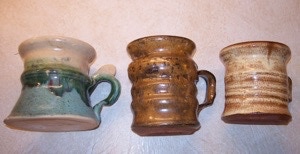
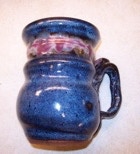

BASIC GLAZE APPICATION:
1.Pot must be bisque-fired first. DO NOT glaze an unfired pot!
2.Sand small burrs from bisque pot. Feel the pot to determine their location. Glaze fired over these witll cut your hand when handling the cup. Glaze is a baked on coating of glass.
3.With damp, clean sponge, wipe pot to remove sanding residue.
4.Stir glazes throughly (every couple of minutes)
5.One stir-stick per glaze (don’t contaminate one glaze with another)
6.Add water if glaze is too thick (consult Professor)
7.Submerge pot in glaze (avoid touching bottom of bucket). Do it quickly - an “in” then “out”
8.Let glaze dry between dunkings.
9.Apply NO MORE THAN TWO COATS of glaze. Should you miss a small spot, dab it with a brush.
10.Wipe any glaze from bottom of pot with clean sponge, then place it on glaze cart.
Brushing on glaze is less effective, but if you do:
1.apply three coats with soft bristle brush, first brushing horizonally, then vertically, finally diagonally.
2.you can better determine where you have brushed , by adding food coloring to second and third applications
USE NO “RED BUCKET” GLAZE ON INSIDE OF POTS.
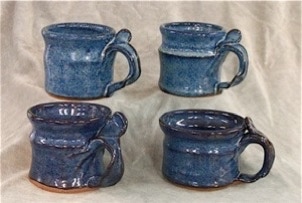
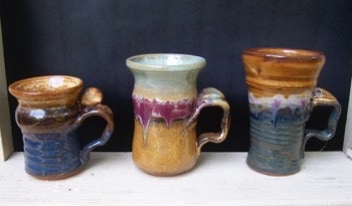
Each cup has a double coat of Floating Blue.
Slight variation in color due to amount of glaze that was randomly applied.
Left cup:
inside & top quarter outsid - one coat of Yellow
Middle cup:
Inside and top third - Spearmint
Bottom - one coat of Iron Red, one of Spearmint
Middle- Thick pasty application of Raspberry (glaze build-up from inside the bucket wall}
Right Cup:
Inside and top third- one coat of Oakleaf, one of yellow
Bottom - Two coats of Floating Blue
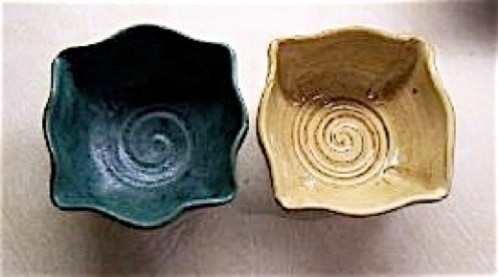
Left bowl - two coats of Jade
Right bowl - two coats of yellow
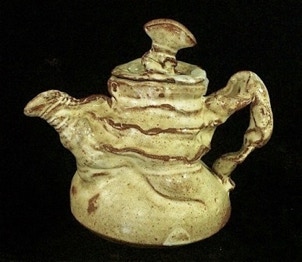
Two coats of Yellow. Brown lines produced by the glazes flowing away from higher ridges. This is the clay showing through.
SOME EFFECTIVE GLAZE COMBINATIONS
JADE
1.Jade and Shiny White
2.Jade and Rasberry
3.Jade and Yellow
4.Jade and Spearmint
5.Two coats= nice waxy surfaced green
Floating Blue
1.Two coats by itself = patterned blue. One coat = chocolate brown
2.With Jade = dark blue-green
3.With Shiny White= patterned light blue
4.With Spearmint = blue-ish green
5.With Raspberry = purple-ish
YELLOW
1.Two coats of it = cream, ivory
2.With Oakleaf = patterned swirls of brown and yellow
3.With Floating Blue = patterned blue-green
IRON RED
1.Two coats to get the “red” to come through
2.With Spearmint = beautiful Cinnamon brown
There are MANY more combinations, but too many to list here, but those above have been very popular with students in past semesters.
However, look at other samples on the wall in the glaze area.